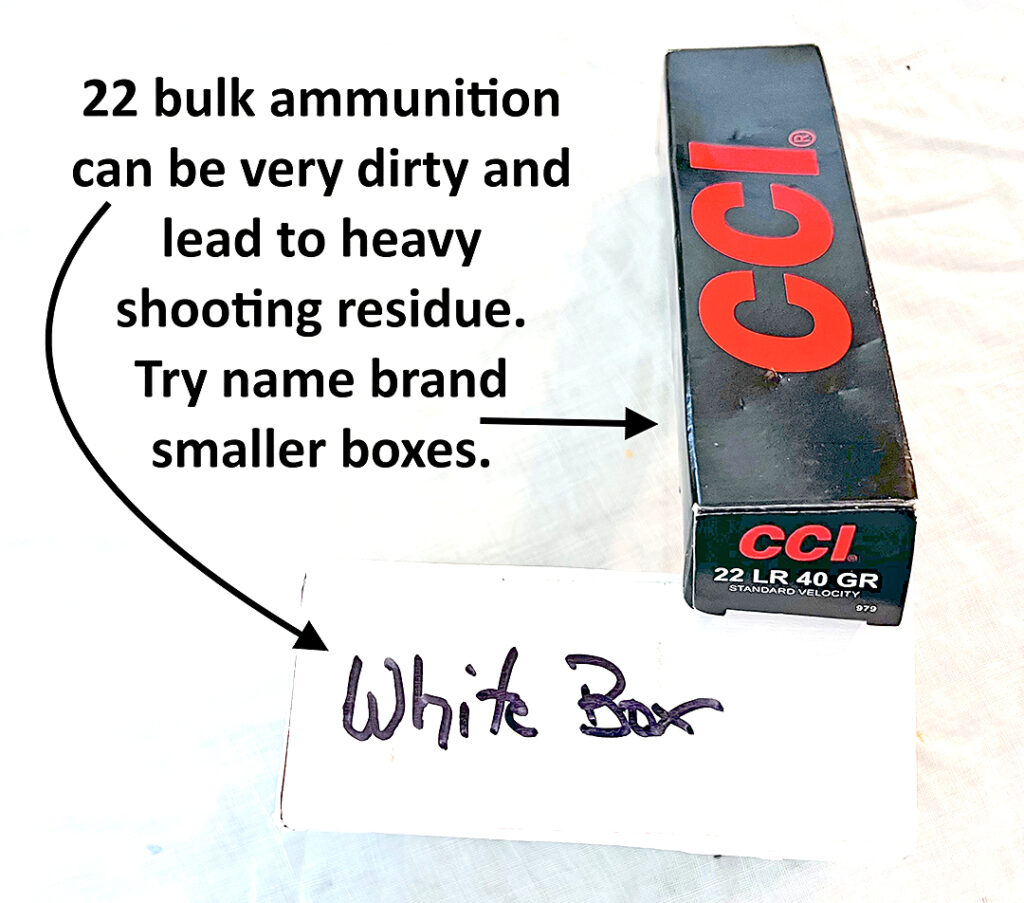What’s wrong with my new gun?


“This is going to be fun!” Karen brings Leslie to the Wakulla County Sheriff’s Office range. This is Karen’s third trip with her Ruger Mark IV, and she’s feeling pretty experienced. Leslie has a new Browning Buckmark, and she has never shot before. Both are .22 caliber pistols.
“I’ve been breaking in my Mark IV,” Karen tells Leslie. “New guns need to be ‘broken in.’ A breaking in period might be shooting about 200 rounds through the gun. I bet I’ve shot 120 rounds so far and today I plan to make it to 150!
“I see you brought your hearing and eye protection,” she continues. “And you remember the range rules posted on that large sign?”
Leslie nods emphatically.
“And you are sure about the meaning of ‘hot’ and ‘cold’?” Karen asks.
Again, Leslie nods.
“OK. Are you ready?”
Leslie nods, this time somewhat uncertainly.
“Now, remember. We are across the red line on the floor, and the range is hot. Keep your finger off the trigger until you are pointing downrange at a target and are ready to shoot.”
Leslie points the gun towards her target, her finger not on the trigger yet.
“Am I holding it right?”
“Yes, your hands are holding just right. Take a breath, let it go slowly, then put your finger on the trigger and squeeze. Don’t jerk your finger. Just squeeze it through.”
Leslie takes a breath and lets it out. She puts her finger on the trigger and squeezes.
“What happened?” she asks as the gun fires, missing the target, and the casing sticks up straight from the ejection port.
“Oh. That’s a stovepipe,” says Karen, knowledgeably.
“Why did that happen?”
“Well, Leslie, you probably limp-wristed the gun. That means you didn’t lock your wrists and have a firm grasp. I’ll take out the casing and you can try again.”
“OK. I’ll hold it more tightly.”
Leslie shoots again. But this time, the round doesn’t fire. Karen takes the gun, pulls the bolt back, and the entire round flies out of the port.
“What did I do?” Leslie asks fearfully.
Karen picks up the round that has fallen to the concrete floor. She inspects the back of it.
“Oh. You see this slight dimple?”
Leslie nods.
“This is a light strike. The firing pin didn’t hit the round solidly enough to ignite the primer. Try it again.”
Lee squeezes the trigger and gets another stovepipe. She puts the gun down and asks: “Will you shoot it and show me what I’m doing wrong?”
Karen picks up the Buckmark with confidence. She takes a breath, lets it go, aims and pulls the trigger. The gun doesn’t fire; it just makes a clicking noise. She pulls back the bolt. The round flies out of the port. Again, a small dimple shows on the back of the round.
Karen tries again. Again, the same result.
“Leslie,” she begins. “Sometimes it happens. Sometimes you just get a defective gun. So, don’t worry. All the major companies stand by their guns. Just send it back. They’ll fix it and return it. No charge!”
Leslie isn’t happy of course. She drops the magazine, pulls back the bolt to make sure there’s nothing in the chamber, and places gun and magazine back in her brand-new pouch.
“Let me shoot off three magazines in my Mark IV. Then we’ll go home and package up your gun,” offers Karen.
Karen pops off a quick 10 rounds, hitting the target every time. She drops the magazine and puts in the next one.
Pop! Pop! Pop! Pop! Pop!
This time, her gun makes that clicking noise and doesn’t fire. The round flies out of the port when she pulls back the bolt. She picks it up and sees the faint indent where the firing pin hit.
“Was that a limp-wrist?” asks Leslie fearfully.
“No.” Karen tries not to look insulted. “Musta been a fluke.”
She aims and squeezes the trigger again. This time, the gun fires but the casing doesn’t come out of the port. It just sticks up.
“Did your gun break?” asks Lee in wonder.
Karen is annoyed, but fortunately, Garry is nearby.
“Hey, Garry! Can you help me? My gun isn’t working right.”
“Sure. May I see it?”
Karen hands him the Mark IV.
“It’s practically new,” she informs him. “I’m working on about 110 rounds through it. Just breaking it in!”
Garry drops the magazine and pulls back the bolt. He looks into the chamber. Then he puts the gun down.
“Can I see your ammunition?” he asks.
Karen hands him a white box. “I got a great deal by buying in bulk!” She is proud of herself for figuring the big box was quite a lot less expensive than a lot of little boxes.
“And,” she says happily, “I didn’t let them sell me that plated stuff, either. I know my gun needs 22 LR ammunition!”
“Ah.” Garry locks the bolt back.
“Look here,” he says, showing Karen the chamber.
“Why, it’s got mud in there!” she huffs. “How’d that happen? I haven’t dropped it!”
“Well, Karen, .22 ammunition is notorious for leaving a lot of shooting residue in the gun. Lead round-nosed cartridges that you buy in bulk often tend to be a lesser quality than name-brand boxes of 100 rounds. I like plated CCI rounds for a .22.”
“Don’t you need LR bullets?”
“Yes, but you might like the LR rounds that are plated. They shoot cleaner.”
“Oh. So, what if the gun is dirty inside? What’s the big deal? Why doesn’t it shoot right?”
“The .22s get fouled pretty easily. The built-up shooting residue slows the firing pin from hitting the casing’s primer firmly, so the primer doesn’t ignite. Then, when you pull back the bolt, the round flies out of the ejection port with a light dimple. Or you can get a stovepipe. Residue on the rails of the bolt can slow down the bolt’s action. When this happens, the slide doesn’t move rearward far enough so that it can eject the casing. The casing then can’t leave the ejection port and, instead, sticks up in the port.”
“So, what do I do?” Karen wonders.
“You have to fieldstrip the gun and clean the insides.”
“I have a snake. Great. I can run it through. But, what’s fieldstrip?”
“Cleaning your gun is more than running a ‘snake’ through it. You need to take it apart, so you can clean all that residue out. That requires cleaning tools and solvent. Finally, you add a very light coat of lubricant on the bolt so it moves smoothly back and forth.”
“But, Garry,” asks Leslie. “My gun is brand new and it isn’t working, either. What’s wrong with it?”
“When you first read the manual and cleaned it, did you notice a lot of grease inside? Many guns are shipped with a rather heavy coating of preservative. This keeps the metal parts from rusting. It, like shooting residue, can keep the gun from firing properly. There may even be goop slowing the firing pin from moving forward. Every gun should be cleaned according to its manual before you shoot it.”
“Then maybe my gun’s OK.” Leslie is relieved. “You’re right. I didn’t clean it,” she admits.
“Karen, you and Leslie both have great handguns. Why don’t we pick a day and learn how to fieldstrip, clean and lube them?”
Karen and Lee are happy to accept his help.
“I didn’t even read my manual,” whispers Lee to Karen.
Karen didn’t either, but she wasn’t about to admit that to Lee.
Marj Law is the former director of Keep Wakulla County Beautiful who has become an avid shooter in retirement.


